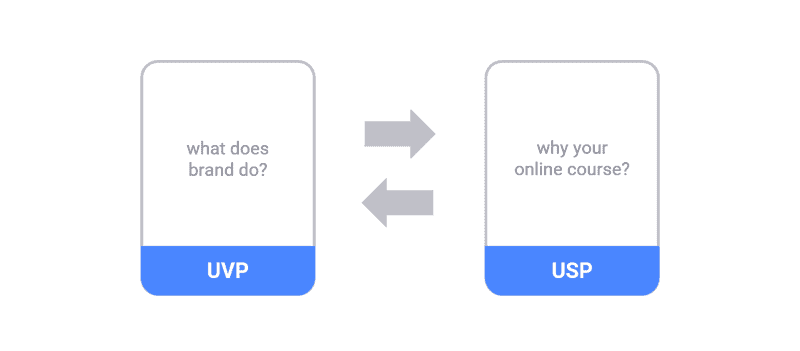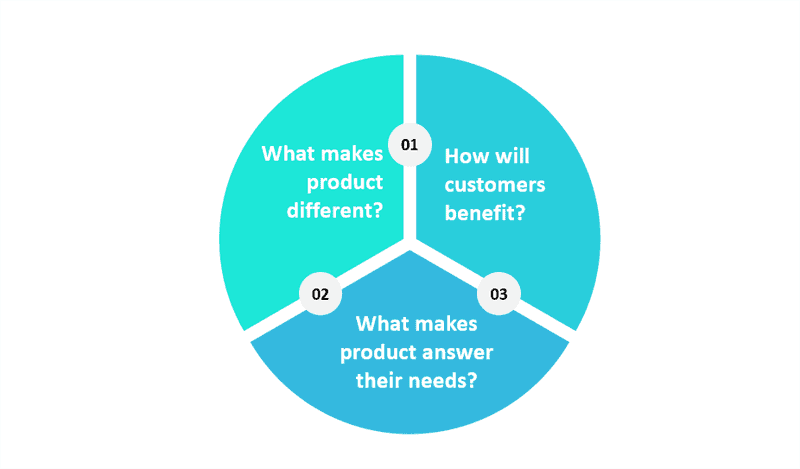Our content is reader supported, which means when you buy from links you click on, we may earn a commission.
Creating a Unique Value Proposition: 9 Key Features of a Good UVP

What convinces customers to purchase your product rather than your competitors?
Is it your product? Is it the pricing? Do you offer your customers enticing bundles and discounts?
While all the factors mentioned above do help you make a sale, they aren’t what attracts a customer to your online course. It’s your business’s Unique Value Proposition (UVP) that sets you apart from your competitors.
What is a Unique Value Proposition?
You may be more familiar with the term Unique Selling Point (USP), which helps separate your product from your competitors. Each product has its own unique selling point that you use to market the product to your competitors. A unique value proposition (or UVP) is essentially your brand’s unique selling point. It is what sets your brand apart from other brands in the same trade.

Though both the terms are often used interchangeably, there is a fundamental difference between the two.
- A UVP answers the question, ‘what does your brand do?’ The answer includes details about your business’s strengths, qualities, and personality.
- A USP answers the question, ‘why your online course?’ The answer is more specific to each product and its particular target market.
Your USP, in part, reflects your brand’s UVP. Suppose your brand’s UVP is to make learning as easy and fun as possible for people of all ages. It could also be to ensure learners have all the tools and resources necessary to feel like a pro at the end of the course.
So, if you are offering an online course on fundamental mathematics for grade 8, your target market will be grade 8. Your course’s USP could include detailed worksheets or features a question-and-answer section at the end of every lesson, where students can ask queries and clear their concepts.
Competition
As an online course creator, you face tough competition out there, especially with big names like Udemy, Skillshare, Coursera, edX, and more. These are all well-established sites with a substantial following. Each of them has its own unique value proposition that sets them apart from and earns them their individual followers and clients.
Udemy, for example, is known as the one-stop shop for course creators and learners alike. Here, you can find lessons, tutorials, and online courses from 13+ main categories. It also offers its customers a wide range of free online courses, making it accessible for anyone who wants to learn. These are all unique value propositions Udemy offers its clients.
Coursera is a major Udemy competitor. To set itself apart from Udemy, it established itself as a high authority online course provider. Here, learners can access courses and minor degrees from some of the best universities. These courses are ideal for those who don’t just want to learn but want to use these courses to improve their CV and professional qualifications.
Why is Having a Good UVP Important?
As we mentioned earlier, as an online course creator, you will face tough competition out there. You’ll not only be competing with big names like Udemy and Skillshare but also smaller websites and businesses all trying to make their mark. If you want to attract customers and run a profitable online course creation business, you will have to convince visitors that your course is better.
There are several ways you can do that. But the first step will always be to establish a Unique Value Proposition as it will help get the point across that you have something more to offer. You will obviously back up the claim with stats and facts. Here, we bring you a few tips on how to write a good unique value proposition.
How to Create a Good UVP?
There is an art to drafting an excellent UVP. Here are a few pointers to help you get started.

A UVP has three main components answering three critical questions for the customer.
- How will the customers benefit from your offer?
- What makes your product the answer to their needs?
- What makes your offer different from your competitors?
As an online course creator, your main goal is to establish that you are better than the other established online course creators. However, gaining trust and building a loyal customer base will take time. So, you will have to start small and let your customers know that you offer more than your competitors do, and you will let them know that through your UVP.
For example:
“The Gateway to Knowledge. Every lesson we create, we create for the betterment of our learners. If it can help you, you will find it here, and you will find it easily, without breaking your bank.”
Now here you clearly state:
- How the customers benefit from your service or offer – they get to increase their knowledge.
- What makes your product the answer for their needs – you clearly exhibit you are a client-centered business and have a variety of products to meet their needs.
- What makes your product different from your competitors – your affordable pricing and ease of use.
This is a very general example, but I think you can see the point.
Stats and Facts
As we mentioned earlier, you will have to back up your statement with stats and facts. So, your homepage should ideally include testimonials or figures about how many followers you have and how many are repeat customers.
You could also take it a step further and truly establish yourself as different and better than your competitor. For example, Udemy is a one-stop-shop for learners and has a market reputation that backs up that claim. So you will have to go the extra mile and provide your customer with the value.

You can do this in multiple ways:
- Include a detailed summary about the course instead of a few pointers like Udemy, and other sites do.
- You can provide offers and services such as additional pdf material as lead magnets to increase leads and conversions.
- You can offer clients a sneak peek into the courses by offering short previews of each lesson. Not many other sites do that, so you will definitely get an edge over competitors.
- You could put up introductory videos of each tutor offering a course on your website. It will give the tutors a chance to introduce themselves, establish their authority making the learner feel like they know who is teaching the course.
Together, the entire package will help you create a Unique Value Proposition that will help set you apart from new and established competitors alike. But before you write down your UVP, you should conduct competitor analysis.
Competitor Analysis
A competitor analysis will help you understand what others are offering and what you can do to provide your customers more value. You will have to identify what they are offering their customers and how you can provide a better offer.

The key here is to make sure you let the customers know exactly how they can benefit from your services. Will your course help them get a better SAT score? Will it help them develop a skill? You need to be specific.
Here it is important to note that though every online course creator is your competitor, you may not be able to conduct a competitor analysis for all other courses. Make sure you take your time to pick out the ones that have the same target market as yours or the ones that you want to compete against.
If you are starting up, try to start slow and use bigger names like Skillshare and Udemy as inspiration and smaller online course offering platforms as competition. You can always change your strategy and switch up who your main competitor will be. You may even need to change your UVP over time. Your business and your competitors’ businesses will grow, goals will change, and so on.
Again, you cannot make a general claim such as “We are the best at what we do, and we are number 1”. It doesn’t work. That’s just fluff. You will have to spell out the benefits, the time frame, payment options, and course-specific features. Then make it easy to understand.
Key Features of a UVP
Make sure you put in the time and effort required to write an excellent UVP. It is absolutely essential for your business’s success, so you should not take it lightly. Here are some key features you must include:
1. It Should Be Unique
Generalized UVPs defeats the purpose of a good Unique Value Proposition. No matter how long it takes, make sure you find what sets you apart from your competitors and draft your UVP around what makes you unique.
If it sounds like what everybody else offers, it’s not going to be very appealing. Your visitors will probably not even read a generic statement about your company. If your brand donates a part of the profit, you could use that in your UVP. If your company or your business uses a socially responsible business operational mechanism, you could use that in your UVP.
Highlight the differences that can be beneficial for your customers, as all your competitors will essentially offer the same services. They are all offering online courses. So why should they trust you with their learning process instead of a much more renowned name? Are you offering accredited courses? Are your courses fun? Or do they use best learning practices to help learners accomplish the goal? Spell it out.
2. It Should Be Attention-Grabbing
Unleash your creativity here. It should make them want to read more. Put a little bit of heart and soul into your UVP as it is quite literally your branding statement, marketing slogan, lead magnet, and sales pitch all in one.
There are several ways you can write an attention-grabbing UVP. Go for a play on words to write a pun or make a joke. You could use a current trend to draft a temporary and unique UVP. Try to keep it unique and attention-grabbing by using visuals to explain or complement your words.
It’s not always necessary to use a unique set of words to describe your services. You can even use an unorthodox means of communication to win over your clientele. Use graphics, animations, and doodle videos to communicate your UVP with your clientele. Even if you offer a lot more payment options than your competitors, use it to your advantage.
3. It Should Be Relevant
It goes without saying that your UVP should be true to your brand and your business. If you try to use another business in another market or niche as inspiration, you run the risk of creating content that isn’t relevant to you or your audience. Make sure you do an audience analysis to make sure you know who you are writing for and then write accordingly.
Keep your services in mind, your end goal in mind, your brand’s uniqueness in mind, but most of all, your customers in mind when writing a UVP. You will have to write for those you want to attract.
4. It Must Be Concise
You cannot write a half a page block of text and call it a UVP. But it should not be a one-liner either as that is more of a slogan or a marketing chant. You need to find the perfect balance so try to summarise all that you want to relay to the customers in around three to four lines maximum.

Write down all the points you want to cover. Merge any two to three points into one wherever you can. Put all the points together into two to three statements. Once you have it, you can go over the statement one more time and eliminate all the unnecessary points or those that are repetitive.
Once you have a two-to-four-line proposition that sounds true to your brand, you should be good to go. It can be used in the hero section of your site or sales letter. That is often where a headline and subheading go along with a relevant image.
5. It Should Be Clear and Well-Written
Grammatical errors and vague, confusing statements will get you nowhere.
Even if you want to write the statement yourself, you can hire a helper to go over it, edit and make changes if needed. As an online course creator, you need to ensure your content is up to par and incredibly high-quality, as that will help you establish yourself as an authority.
6. It should Be Straightforward But Difficult to Copy
Just because you are trying to establish yourself as an expert does not mean you should write statements that are overly complex or difficult to follow. Make sure the statement is pretty straightforward, easy to understand, simple yet unique to your brand.
The more unique or personalized it is, the better it will be for your business as it will be harder to copy or plagiarise. Add in as many brand-specialized references as possible to ensure you don’t have to fight for copyrights or accuse competitors of plagiarising your UVP.
7. It Must Include the Main Features of Benefits
Udemy is famous for being the one-stop-shop for all your learning needs and requirements. It ensures the provision of several courses in over 13 categories and 9 languages.

That is the main feature or benefit that it uses to market its courses. It also claims to offer free courses to make e-learning accessible and affordable for everyone.
Make sure your UVP includes the main features and benefits of using your business. Try not to copy everything from competitors and include what you think will attract your customers. But make sure your UVP consists of all the features and benefits.
8. It Should End with How the Customers Can Benefit From it.
Your UVP must let your customers know exactly what you are offering them. If your online health and fitness courses can help them become more fit and lose weight within 4 weeks or so, let them know that.
However, you may not be able to include the value or benefits your customers will get from each course, so make sure you have a generalized goal for all your courses. It could be anything from helping learners become experts in the field of their choice or improving their skill set.
You can even provide them guarantees or let them know that all course instructors are professionals with expertise in their relative fields.
9. Include a CTA!
Lastly, but most importantly, you should include a Call to Action such as ‘Sign-Up! It’s Free!’, or you can include an offer in your CTA such as ‘Sign-up Now and Get 25% Off your first Two Courses.’

A CTA is important as it helps you make the sale. Your viewers read through all the benefits they can get from your business, and the CTA helps you sell the product almost immediately. Your Unique Value Proposition will help you build long-lasting relationships with your customers as it is more of a life-long promise that you make to your potential customers.
Frequently Asked Questions on UVPs
How do you identify a unique value proposition?
To identify a unique value proposition, you need to know what makes your product or service different from others in your market. Ask yourself what benefit your product or service offers that others do not. It could be a unique feature, a more affordable price point, or better quality.
Once you identify what sets your offering apart, you can craft a message that highlights this. Put that at the center of your marketing strategy.
Keep in mind that your unique value proposition should be clear. It should also be concise and easy for potential customers to understand.
What are examples of unique value propositions?
There are many different elements that can make up a UVP. For example, unique features, superior quality, or better customer service are UVPs.
You may also have a unique selling point (USP). This is a feature of your product or service not offered by anyone else. Whatever it is that makes your business unique, make sure to highlight it in your UVP.
If you’re not sure how to create a UVP for your business, start by looking at your competition. What are they offering, and how can you do better?
Keep in mind that your UVP should be realistic and achievable; don’t make promises you can’t keep! Once you’ve figured out what makes your business unique, craft a simple statement to convey it.
What is the difference between a unique value proposition vs unique selling proposition?
A unique selling proposition (USP) summarizes how your company, product, or service is different from your competitors.
It’s often used in advertising and marketing materials to help prospects understand what you offer and why they should buy from you.
A unique value proposition (UVP) is like a USP, but it goes beyond outlining what makes your product or service unique. It also explains how your unique offering will provide value to your target customer and help them solve a specific problem.
A UVP is shorter and more focused than a USP.
To sum it up, a USP targets what makes you different, while a UVP explains how that difference benefits your customer.
Conclusion
You’ve seen all the elements of a unique value proposition now so you start putting one together for your company. Remember, it can always evolve over time. Your first version doesn’t have to be your last version. Listen to your customers and you can evolve your UVP to keep up with the trends in your industry. This will help you outlast the competition and gain your foothold in the industry.